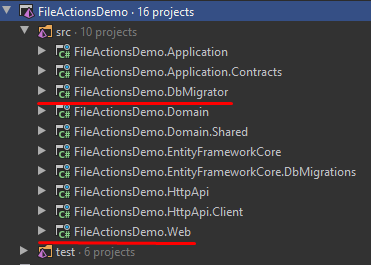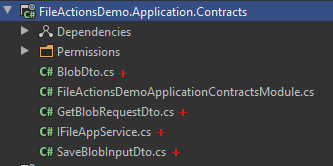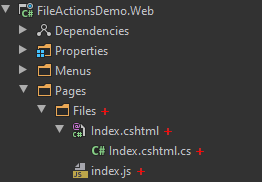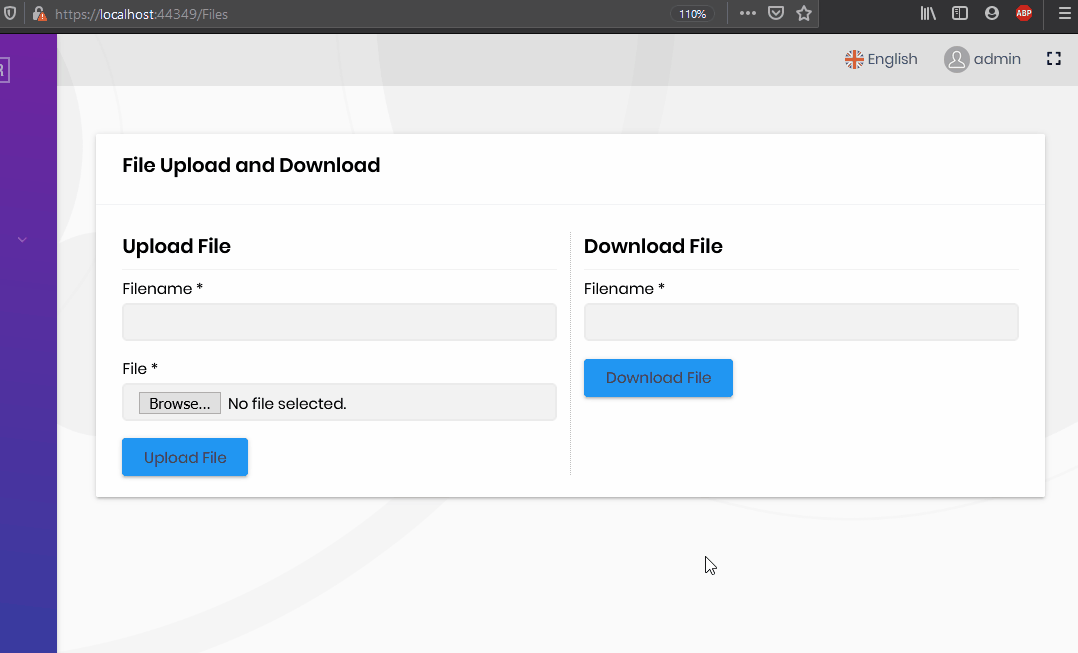File Upload/Download with BLOB Storage System in ASP.NET Core & ABP Framework
Introduction
This step-by-step article describes how to upload a file to a Web server and also download by client with using ASP.NET Core & ABP Framework. By following this article, you will create a web project and its related code to upload and download files.
Before the creating application, we need to know some fundamentals.
BLOB Storing
It is typical to store file contents in an application and read these file contents on need. Not only files, but you may also need to save various types of large binary objects, a.k.a. BLOBs, into a storage. For example, you may want to save user profile pictures.
A BLOB is a typically byte array. There are various places to store a BLOB item; storing in the local file system, in a shared database or on the Azure BLOB storage can be options.
The ABP Framework provides an abstraction to work with BLOBs and provides some pre-built storage providers that you can easily integrate to. Having such an abstraction has some benefits;
- You can easily integrate to your favorite BLOB storage provides with a few lines of configuration.
- You can then easily change your BLOB storage without changing your application code.
- If you want to create reusable application modules, you don't need to make assumption about how the BLOBs are stored.
ABP BLOB Storage system is also compatible to other ABP Framework features like multi-tenancy.
To get more information about ABP BLOB Storing system, please check this documentation.
Preparing the Project
Startup template and the initial run
Abp Framework offers startup templates to get into the business faster. We can download a new startup template using Abp CLI:
abp new FileActionsDemo -m none
After the download is finished, we run FileActionsDemo.DbMigrator project to create the database and seed initial data (admin user, role, etc). Then we run FileActionsDemo.Web to see our application working.
Default admin username is admin and password is 1q2w3E*

Adding Blob Storing Module
For this article, we use Blob Storing Database Provider.
You can use Azure or File System providers also.
Open a command prompt (terminal) in the folder containing your solution (.sln) file and run the following command:
abp add-module Volo.Abp.BlobStoring.Database
This action will add the module dependencies and also module migration. After this action, run FileActionsDemo.DbMigrator to update the database.
Setting up Blob Storage
BLOB Storage system works with Containers. Before the using blob storage, we need to create our blob container.
Create a class that name MyFileContainer at the FileActionsDemo.Domain project.
using Volo.Abp.BlobStoring;
namespace FileActionsDemo
{
[BlobContainerName("my-file-container")]
public class MyFileContainer
{
}
}
That's all, we can start to use BLOB storing in our application.
Creating Application Layer
Before the creating Application Service, we need to create some DTOs that used by Application Service.
Create following DTOs in FileActionsDemo.Application.Contracts project.
BlobDto.csnamespace FileActionsDemo { public class BlobDto { public byte[] Content { get; set; } public string Name { get; set; } } }GetBlobRequestDto.csusing System.ComponentModel.DataAnnotations; namespace FileActionsDemo { public class GetBlobRequestDto { [Required] public string Name { get; set; } } }SaveBlobInputDto.csusing System.ComponentModel.DataAnnotations; namespace FileActionsDemo { public class SaveBlobInputDto { public byte[] Content { get; set; } [Required] public string Name { get; set; } } }
Create IFileAppService.cs interface at the same place with DTOs.
IFileAppServiceusing System.Threading.Tasks; using Volo.Abp.Application.Services; namespace FileActionsDemo { public interface IFileAppService : IApplicationService { Task SaveBlobAsync(SaveBlobInputDto input); Task<BlobDto> GetBlobAsync(GetBlobRequestDto input); } }
After creating DTOs and interface, FileActionsDemo.Application.Contracts project should be like as following image.

Then we can create our Application Service.
Create FileAppService.cs in FileActionsDemo.Application project.
using System.Threading.Tasks;
using Volo.Abp.Application.Services;
using Volo.Abp.BlobStoring;
namespace FileActionsDemo
{
public class FileAppService : ApplicationService, IFileAppService
{
private readonly IBlobContainer<MyFileContainer> _fileContainer;
public FileAppService(IBlobContainer<MyFileContainer> fileContainer)
{
_fileContainer = fileContainer;
}
public async Task SaveBlobAsync(SaveBlobInputDto input)
{
await _fileContainer.SaveAsync(input.Name, input.Content, true);
}
public async Task<BlobDto> GetBlobAsync(GetBlobRequestDto input)
{
var blob = await _fileContainer.GetAllBytesAsync(input.Name);
return new BlobDto
{
Name = input.Name,
Content = blob
};
}
}
}
As you see in previous code block, we inject IBlobContainer<MyFileContainer> to our app service. It will handle all blob actions for us.
SaveBlobAsyncmethod usesSaveAsyncofIBlobContainer<MyFileContainer>to save the given blob to storage, this is a simple example so we don't check is there any file exist with same name. We sent blob name, blob content andtrueforoverrideExistingparameter.GetBlobAsyncmethod is usesGetAllBytesAsyncofIBlobContainer<MyFileContainer>to get blob content by name.
We finished the application layer for this project. After that we will create a Controller for API and Razor Page for UI.
Creating Controller
Create FileController.cs in your FileActionsDemo.HttpApi project.
using System.Threading.Tasks;
using Microsoft.AspNetCore.Mvc;
using Volo.Abp.AspNetCore.Mvc;
namespace FileActionsDemo
{
public class FileController : AbpController
{
private readonly IFileAppService _fileAppService;
public FileController(IFileAppService fileAppService)
{
_fileAppService = fileAppService;
}
[HttpGet]
[Route("download/{fileName}")]
public async Task<IActionResult> DownloadAsync(string fileName)
{
var fileDto = await _fileAppService.GetBlobAsync(new GetBlobRequestDto{ Name = fileName });
return File(fileDto.Content, "application/octet-stream", fileDto.Name);
}
}
}
As you see, FileController injects IFileAppService that we defined before. This controller has only one endpoint.
DownloadAsync is using to send file from server to client.
This endpoint is requires only a string parameter, then we use that parameter to get stored blob. If blob is exist, we return a File result so download process can start.
Creating User Interface
We will create only one page to prove download and upload actions are working.
Create folder that name Files in your Pages folder at FileActionsDemo.Web project.
Create a Razor page that name Index with its model.
Index.cshtml.cs
using System.ComponentModel.DataAnnotations;
using System.IO;
using System.Threading.Tasks;
using Microsoft.AspNetCore.Http;
using Microsoft.AspNetCore.Mvc;
using Volo.Abp.AspNetCore.Mvc.UI.RazorPages;
namespace FileActionsDemo.Web.Pages.Files
{
public class Index : AbpPageModel
{
[BindProperty]
public UploadFileDto UploadFileDto { get; set; }
private readonly IFileAppService _fileAppService;
public bool Uploaded { get; set; } = false;
public Index(IFileAppService fileAppService)
{
_fileAppService = fileAppService;
}
public void OnGet()
{
}
public async Task<IActionResult> OnPostAsync()
{
using (var memoryStream = new MemoryStream())
{
await UploadFileDto.File.CopyToAsync(memoryStream);
await _fileAppService.SaveBlobAsync(
new SaveBlobInputDto
{
Name = UploadFileDto.Name,
Content = memoryStream.ToArray()
}
);
}
return Page();
}
}
public class UploadFileDto
{
[Required]
[Display(Name = "File")]
public IFormFile File { get; set; }
[Required]
[Display(Name = "Filename")]
public string Name { get; set; }
}
}
As you see, we use UploadFileDto as a BindProperty and we inject IFileAppService to upload files.
The UploadFileDto is requires a string parameter for using as a blob name and a IFormFile that sent by user.
At the post action (OnPostAsync), if everything is well, we use MemoryStream to get all bytes from file content.
Then we save file with SaveBlobAsync method of IFileAppService.
Index.cshtml
@page
@model FileActionsDemo.Web.Pages.Files.Index
@section scripts{
<abp-script src="/Pages/Files/index.js" />
}
<abp-card>
<abp-card-header>
<h3>File Upload and Download</h3>
</abp-card-header>
<abp-card-body>
<abp-row>
<abp-column>
<h3>Upload File</h3>
<hr />
<form method="post" enctype="multipart/form-data">
<abp-input asp-for="UploadFileDto.Name"></abp-input>
<abp-input asp-for="UploadFileDto.File"></abp-input>
<input type="submit" class="btn btn-info" />
</form>
</abp-column>
<abp-column style="border-left: 1px dotted gray">
<h3>Download File</h3>
<hr />
<form id="DownloadFile">
<div class="form-group">
<label for="fileName">Filename</label><span> * </span>
<input type="text" id="fileName" name="fileName" class="form-control ">
</div>
<input type="submit" class="btn btn-info"/>
</form>
</abp-column>
</abp-row>
</abp-card-body>
</abp-card>
We divided the page vertically, left side will be using for upload and right side will be using for download. We use ABP Tag Helpers to create page.
index.js
$(function () {
var DOWNLOAD_ENDPOINT = "/download";
var downloadForm = $("form#DownloadFile");
downloadForm.submit(function (event) {
event.preventDefault();
var fileName = $("#fileName").val().trim();
var downloadWindow = window.open(
DOWNLOAD_ENDPOINT + "/" + fileName,
"_blank"
);
downloadWindow.focus();
});
$("#UploadFileDto_File").change(function () {
var fileName = $(this)[0].files[0].name;
$("#UploadFileDto_Name").val(fileName);
});
});
This jQuery codes are using for download. Also we wrote a simple code to autofill Filename input when user selects a file.
After creating razor page and js file, FileActionsDemo.Web project should be like as following image.

Result
After completing code tutorial, run FileActionsDemo.Web project and go /Files. You can upload any file with any name and also download those uploaded files.



























































Comments
crash sol 270 weeks ago
NICE
qais_kateeb@hotmail.com 256 weeks ago
Thanks for this article, I'm trying to have a "ListBlobs" functionality on the container, what is the best approach you think, should I use the Database Provider Directly ? or Override the Implementation on the Storage Module ?
najumal59@gmail.com 248 weeks ago
Hello. Have you got the solution for this? am trying to do the same.
Ahmet Çotur 248 weeks ago
Hi,
Blob Storage system does not provide "GetList" action, because it is only does "write & get".
I don't suggest to override Storage Module.
If you want to manage blobs, you should create an entity like "MyBlob". When you save blob, you should create MyBlob entity also (1-to-1 relation with blob)
As a result, you can manage&view your blobs with MyBlob entity.
I can prepare a video course about that. :)
qais_kateeb@hotmail.com 248 weeks ago
Thanks @Ahmet for you advise. For me what i did is to use and extend IDatabaseBlobRepository and IDatabaseBlobContainerRepository in the appservice
qais_kateeb@hotmail.com 248 weeks ago
Also @Ahmet please note that you may face some limitations with the solution you proposed, because SaveAsync does not return the id of the blob after insertion. I think it will not be easy to have the relation on this case
Ahmet Çotur 248 weeks ago
Actually, you can create
MyBlobfirst then you can use the id of the Entity as a Blob Name.pdpalma@hotmail.com 243 weeks ago
Hi! I'm having a problem with migrations. I've runned the migrator project but for some reason when i try upload a file, the system throws me this error:
SqlException: Invalid object name 'AbpBlobContainers'. Microsoft.Data.SqlClient.SqlCommand+<>c.<ExecuteDbDataReaderAsync>b__169_0(Task<SqlDataReader> result)
This object doesn't exists in database.
Some idea?
Thanks.
Ahmet Çotur 243 weeks ago
Hi,
Probably the database is not updated by migrations. Did you create new migrations? If not, please add new migrations first to your
XX.EntityFrameworkCore.DbMigrationsproject then run DbMigrator.pdpalma@hotmail.com 243 weeks ago
Hi! Now it's works. I did forget it run the new megration for blobs containers. Thanks!
Learn ABP Framework 240 weeks ago
Hey Ahmet Cotur
how are you displaying the message on sucessfull submit ... i dont see the code for that in your tutorial
Ahmet Çotur 240 weeks ago
It was MVC project, and you can use " abp.message.success("This is success message.") " for it. In other UI types, it should be different.
Learn ABP Framework 240 weeks ago
That’s what I am doing but the message displays but because of the post the page refreshes so the message doesn’t wait for the user to click okay it disappears .... how do I make the message stay after submit ?
genoher 166 weeks ago
I have a question about ABP blob store and Aws, I thought maybe you could solve it. I would like to know how to specify the path to save the file, by default it saves it inside a "host" folder. I wish I could change it. I tried renaming the file $"/newPath/{filename}", but it didn't work for me. Thank you very much, I am very grateful for this post, it has helped me a lot.
Kendall Bennett 159 weeks ago
Sorry, but this is a terrible sample application. I ran across this as I like the idea of auto generated controllers and clients for the REST services, but I was expecting to see this blog post show how you would stream a file as an upload or a download. While the download renders as a stream, the upload certainly does not and sending files over the wire as a JSON byte array is the worst way to do this!
Not to mention passing the blob to and from the blob service as a byte array also, rather than using streams to avoid all the data copying. So this example is extremely inefficient and IMHO the incorrect way to show folks how to do this.
I will keep looking, but someone should re-do the blog post showing the correct way to stream a file upload and download using ABP and also use streaming functions to move the blob data in and out of the blog storage service.
gentledepp 106 weeks ago
Please note that because you are using byte[] and MemoryStream, you are actually loading all uploaded/downloaded files into memory. This is an absolute no-go for server applications and should be avoided at all costs! The reason is, that if 3 requests try to download a 4GB file, you end up with 12GB memory usage with just 3 requests!
Please consider to update your sample to use the IRemoteStreamContent of the abp framework. You can read the docs here: https://docs.abp.io/en/abp/7.4/Application-Services#miscellaneous